
The aardwolf is an insectivorous species of hyena, native to East and Southern Africa. Its name means "earth-wolf" in Afrikaans and Dutch. It is also called the maanhaar-jackal, termite-eating hyena and civet hyena, based on its habit of secreting substances from its anal gland, a characteristic shared with the African civet.

Hyenas, or hyaenas, are feliform carnivoran mammals belonging to the family Hyaenidae. With just four extant species, it is the fifth-smallest family in the Carnivora and one of the smallest in the class Mammalia. Despite their low diversity, hyenas are unique and vital components of most African ecosystems.

Machairodus is a genus of large machairodont or ''saber-toothed cat'' that lived in Africa, Eurasia and North America during the late Miocene. It is the animal from which the subfamily Machairodontinae gets its name and has since become a wastebasket taxon over the years as many genera of sabertooth cat have been and are still occasionally lumped into it.

The Gruiformes are an order containing a considerable number of living and extinct bird families, with a widespread geographical diversity. Gruiform means "crane-like".

In zoological nomenclature, a type species is the species name with which the name of a genus or subgenus is considered to be permanently taxonomically associated, i.e., the species that contains the biological type specimen. A similar concept is used for suprageneric groups and called a type genus.

Taenia is the type genus of the Taeniidae family of tapeworms. It includes some important parasites of livestock. Members of the genus are responsible for taeniasis and cysticercosis in humans, which are types of helminthiasis belonging to the group of neglected tropical diseases. More than 100 species are recorded. They are morphologically characterized by a ribbon-like body composed of a series of segments called proglottids; hence the name Taenia. The anterior end of the body is the scolex. Some members of the genus Taenia have an armed scolex ; of the two major human parasites, Taenia saginata has an unarmed scolex, while Taenia solium has an armed scolex.

Pachycrocuta is an extinct genus of prehistoric hyenas. The largest and most well-researched species is Pachycrocuta brevirostris, colloquially known as the giant short-faced hyena as it stood about 90–100 cm (35–39 in) at the shoulder and it is estimated to have averaged 110 kg (240 lb) in weight, approaching the size of a lioness, making it the largest known hyena. Pachycrocuta first appeared during the late Miocene. By 800,000 years ago, it became locally extinct in Europe, with it surviving in East Asia until at least 500,000 years ago, and possibly later elsewhere in Asia.
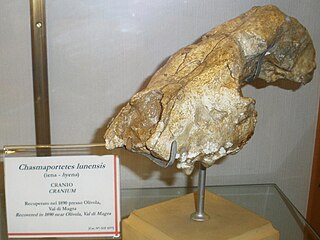
Chasmaporthetes, also known as hunting or running hyena, is an extinct genus of hyenas distributed in Eurasia, North America, and Africa during the Pliocene-Pleistocene epochs, living from 4.9 million to 780,000 years ago, existing for about 4.12 million years. The genus probably arose from Eurasian Miocene hyenas such as Thalassictis or Lycyaena, with C. borissiaki being the oldest known representative. The species C. ossifragus was the only hyena to cross the Bering land bridge into the Americas, and ranged over what is now Arizona and Mexico during Blancan and early Irvingtonian Land Mammal ages, between 5.0 and 1.5 million years ago.

Percrocuta is an extinct genus of hyena-like feliform carnivores. It lived in Europe, Asia, and Africa, during the Miocene epoch.
Armintomys is an extinct genus of rodent from North America related to jerboas and jumping mice. It is the only genus in the family Armintomyidae. It lived during the early Eocene, and is the oldest known example of a hystricomorphous zygomasseteric dentition. In addition, Armintomys is also the oldest known rodent that had an incisor enamel transition from pauciserial to uniserial. Its remains have only been found in the Wind River Basin in Wyoming, and could be found there during the species' existence on Earth. It was previously assumed that Armintomys belonged to the Dipodoidea family, but has since been understood to have been part of an early radiation of dipodoid rodents, but was not directly ancestral to any later dipodoids, thus it was recategorized into its own family.
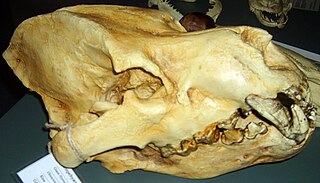
Percrocutidae is an extinct family of hyena-like feliform carnivores endemic to Asia, Africa, and Southern Europe from the Middle Miocene through the Pliocene, existing for about 8 million years.
Pantotheria is an abandoned taxon of Mesozoic mammals. This group is now considered an informal "wastebasket" taxon and has been replaced by Dryolestida as well as other groups. It is sometimes treated as an infraclass and older books refer to it as being related to symmetrodonts. One classification makes it an infraclass with a single order, Eupantotheria.
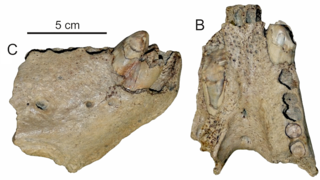
Pelagiarctos was a genus of walrus that lived during the Mid Miocene, approx. 13-15 mya. Its remains have been found in the Sharktooth Hill Bonebed, in Kern County, California. It was originally described as an Otariidae, though it is now usually considered to be a basal Odobenidae.
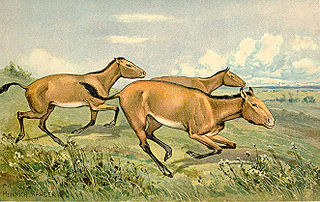
The Vallesian age is a period of geologic time within the Miocene used more specifically with European Land Mammal Ages. It precedes the Turolian age and follows the Astaracian age. The so-called Vallesian Crisis resulted in the extinction of several mammalian taxa characteristic of the Middle Miocene.
Gobicyon is an extinct genus of large-sized carnivoran mammals, belonging to the Amphicyonidae, that was discovered in China, Mongolia, and Serbia, and lived during the Middle Miocene epoch. Despite only being known from rather fragmentary remains, recent discoveries showcase that it was an aberrant member of the subfamily Haplocyoninae, with adaptions towards bone-crushing similar to those of a hyaena.

Ysengrinia is an extinct genus of carnivoran in the family Amphicyonidae (beardogs), which lived in Europe, Asia, and North America during the Early Miocene. It was also reported from Egypt and Namibia, but this material has been reassigned to other genera of beardogs.

Thalassictis is an extinct genus of terrestrial carnivore in the family Hyaenidae that lived in Asia during the Middle to Late Miocene and in Europe and North Africa during the Late Miocene.
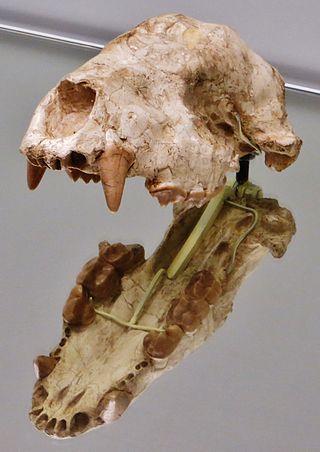
Indarctos is an extinct genus of bear, endemic to North America, Europe and Asia during the Miocene. It was present from ~11.1 to 5.3 Ma, existing for approximately 6.2 million years.

Enhydriodon is an extinct genus of mustelids known from Africa, Pakistan, and India that lived from the late Miocene to the early Pleistocene. It contains 9 confirmed species, 2 debated species, and at least a few other undescribed species from Africa. The genus belongs to the tribe Enhydriodontini in the otter subfamily Lutrinae. Enhydriodon means “otter tooth” in Ancient Greek and is a reference to its dentition rather than to the Enhydra genus, which includes the modern sea otter and its two prehistoric relatives.

















